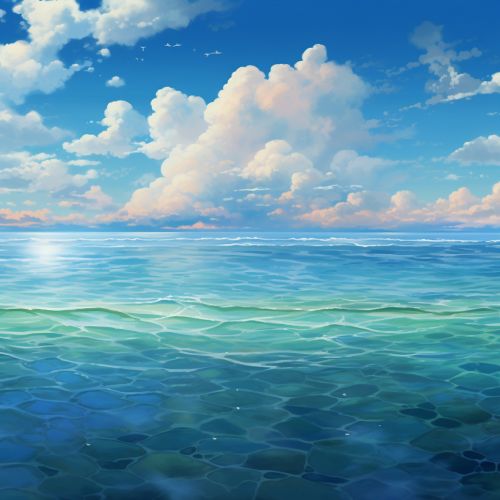Chemical Oceanography
Introduction
Chemical oceanography is the study of ocean chemistry, including the behavior of chemical species, their distributions, and the processes that lead to these distributions. It is a multidisciplinary science that integrates aspects of geochemistry, marine biology, geology, physics, and chemistry.


History of Chemical Oceanography
The field of chemical oceanography has its roots in the early explorations of the ocean. Early oceanographers were primarily interested in the physical properties of the ocean, but they also recognized the importance of chemical measurements. The first chemical analyses of seawater were carried out in the 18th century by Antoine Lavoisier and others. These early studies focused on the major constituents of seawater, such as sodium, chloride, magnesium, and sulfate.
Chemical Composition of Seawater
Seawater is a complex mixture of various chemical elements and compounds. The major constituents of seawater are chloride and sodium, which make up about 85% of the dissolved solids. Other major ions include sulfate, magnesium, calcium, and potassium. In addition to these major constituents, seawater also contains a variety of trace elements and nutrients.
Major Constituents
The major constituents of seawater are the ions that are present in the highest concentrations. These include the cations sodium (Na+), magnesium (Mg2+), calcium (Ca2+), and potassium (K+), and the anions chloride (Cl-), sulfate (SO42-), bicarbonate (HCO3-), and bromide (Br-).
Trace Elements
Trace elements are those that are present in seawater in very low concentrations. Despite their low concentrations, trace elements can have significant impacts on the chemistry and biology of the ocean. Some trace elements, such as iron and zinc, are essential nutrients for marine organisms.
Nutrients
Nutrients in seawater include inorganic compounds of nitrogen, phosphorus, and silicon, which are essential for the growth of marine organisms. These nutrients are typically present in low concentrations in the surface ocean, but can be found in higher concentrations in deeper waters due to the decomposition of organic matter.
Chemical Processes in the Ocean
There are many chemical processes that occur in the ocean, including dissolution, precipitation, adsorption, desorption, complexation, oxidation, and reduction. These processes can affect the distribution and behavior of chemical species in the ocean.
Dissolution and Precipitation
Dissolution is the process by which a solid substance dissolves in a solvent to form a solution. In the ocean, this process can occur when minerals in rocks and sediments come into contact with seawater. Precipitation is the reverse of dissolution and occurs when a substance comes out of solution to form a solid.
Adsorption and Desorption
Adsorption is the process by which atoms, ions, or molecules from a substance (the adsorbate) adhere to the surface of another substance (the adsorbent). In the ocean, this process can occur when dissolved substances in seawater adhere to the surfaces of particles or sediments. Desorption is the reverse of adsorption and occurs when a substance detaches from a surface and goes back into solution.
Complexation
Complexation is the process by which a central metal ion forms a complex with one or more ligands. In the ocean, this process can occur when metal ions in seawater form complexes with organic or inorganic ligands.
Oxidation and Reduction
Oxidation and reduction (redox) reactions involve the transfer of electrons from one substance to another. In the ocean, these reactions can occur in a variety of contexts, including the cycling of nutrients and trace elements, the degradation of organic matter, and the formation and dissolution of minerals.
Biogeochemical Cycles
Biogeochemical cycles describe the transformations and movement of chemical elements in the biosphere, including the ocean. These cycles involve both biological processes, such as photosynthesis and respiration, and geological processes, such as weathering and sedimentation.
Carbon Cycle
The carbon cycle is the biogeochemical cycle by which carbon is exchanged among the biosphere, pedosphere, geosphere, hydrosphere, and atmosphere of the Earth. In the ocean, carbon is cycled through various processes, including photosynthesis, respiration, dissolution and precipitation of calcium carbonate, and the formation and degradation of organic matter.
Nitrogen Cycle
The nitrogen cycle is the biogeochemical cycle by which nitrogen is converted into various chemical forms as it circulates among the atmosphere, terrestrial, and marine ecosystems. In the ocean, nitrogen is cycled through processes such as nitrogen fixation, nitrification, denitrification, and the decomposition of organic matter.
Phosphorus Cycle
The phosphorus cycle is the biogeochemical cycle that describes the movement of phosphorus through the lithosphere, hydrosphere, and biosphere. In the ocean, phosphorus is cycled through processes such as weathering of rocks, adsorption and desorption on particles, and the uptake and release by marine organisms.
Chemical Tracers in Oceanography
Chemical tracers are substances that can be used to trace the movement of water masses in the ocean. These tracers can be naturally occurring or artificially introduced, and they can provide valuable information about ocean circulation, mixing processes, and the exchange of water between different parts of the ocean.
Stable Isotopes
Stable isotopes are isotopes that do not undergo radioactive decay. In the ocean, stable isotopes of elements such as oxygen and carbon can be used as tracers to study processes such as water mass formation, air-sea gas exchange, and biological productivity.
Radioactive Isotopes
Radioactive isotopes are isotopes that undergo radioactive decay. In the ocean, radioactive isotopes such as tritium, carbon-14, and radium isotopes can be used as tracers to study processes such as ocean circulation, mixing, and the age of water masses.
Future Directions in Chemical Oceanography
As our understanding of the ocean continues to grow, new questions and challenges arise in the field of chemical oceanography. These include understanding the impacts of climate change on ocean chemistry, exploring the role of the ocean in the global carbon cycle, and investigating the biogeochemical cycles of trace elements and their isotopes.
